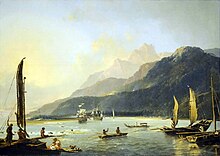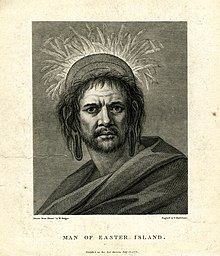'Eua History
ʻEua was put on the European maps by Abel Tasman who reached it and Tongatapu on 21 January 1643. He called it Middelburg Island, after the Dutch city of Middelburg, Zeeland. He did not go on land, but proceeded to the Hihifo district of Tongatapu, which he named Amsterdam Island after the capital of the Netherlands.
'Eua was considered by early Missionaries as heathen as it was the rendezvous for whalers, a place that you can trade goods for guns, knives, axes and gunpowder. aka arsenal, or armory of Tonga, as well as its granary.
Captain James Cook visited the island in 1773 and 1777. On his map, it is named Eaoowe.[4]
This article includes a list of general references, but it lacks sufficient corresponding inline citations. (March 2019) |
William Hodges RA (28 October 1744 – 6 March 1797) was an English painter.[1] He was a member of James Cook's second voyage to the Pacific Ocean and is best known for the sketches and paintings of locations he visited on that voyage, including Table Bay, Tahiti, Easter Island, New Zealand, Dusky Sound and the Antarctic.
Biography
Hodges was born on 28 October 1744 in London. He studied under William Shipley and afterwards in the studio of Richard Wilson, where he met Thomas Jones.
During his early career, he made a living by painting theatrical scenery.
Between 1772 and 1775 Hodges accompanied James Cook to the Pacific as the expedition's artist. Some of his expedition paintings have a marked resemblance in terms of epic scope and sweep of the Hudson River School of Art. Many of his sketches and wash paintings were adapted as engravings in the original published edition of Cook's journals from the voyage.
Most of the large-scale landscape oil paintings from his Pacific travels for which Hodges is best known were finished after his return to London; he received a salary from the Admiralty for the purposes of completing them. These paintings depicted a stronger light and shadow than had been usual in European landscape tradition. Contemporary art critics complained that his use of light and colour contrasts gave his paintings a rough and unfinished appearance.
Hodges also produced many valuable portrait sketches of Pacific islanders and scenes from the voyage involving members of the expedition.
In 1778, under the patronage of Warren Hastings, Hodges travelled to India, one of the first British professional landscape painters to visit that country. He remained there for six years, staying in Lucknow with Claude Martin in 1783.[2] His painting of "Futtypoor Sicri" is in Sir John Soane's Museum. In 1794 Hodges published an illustrated book about his travels in India.[3]
Later Hodges travelled across Europe, including a visit to St. Petersburg in Russia in 1790.
In December 1794 Hodges opened an exhibition of twenty-five of his own works at Orme's Gallery, 14 Old Bond Street, London that included two large paintings called The Effects of Peace and The Effects of War. In late January 1795, with Britain engaged in the War of the First Coalitionagainst Revolutionary France and feelings running high, the exhibition was visited by Prince Frederick, Duke of York and Albany, the second son of King George III. The Duke took offence at the political nature of Hodges' paintings and ordered the exhibition closed; this royal censure effectively ended Hodges' career as a painter. Many of his works were then sold by auction but produced only an inconsiderable sum.
Hodges retired to Devon and became involved with a bank, which failed during the banking crisis of March 1797. On 6 March of that year, he died from what was officially recorded as "gout in the stomach", but which was also rumoured to be suicide from an overdose of laudanum.
Hodges Knoll in Antarctica is named after William Hodges.



